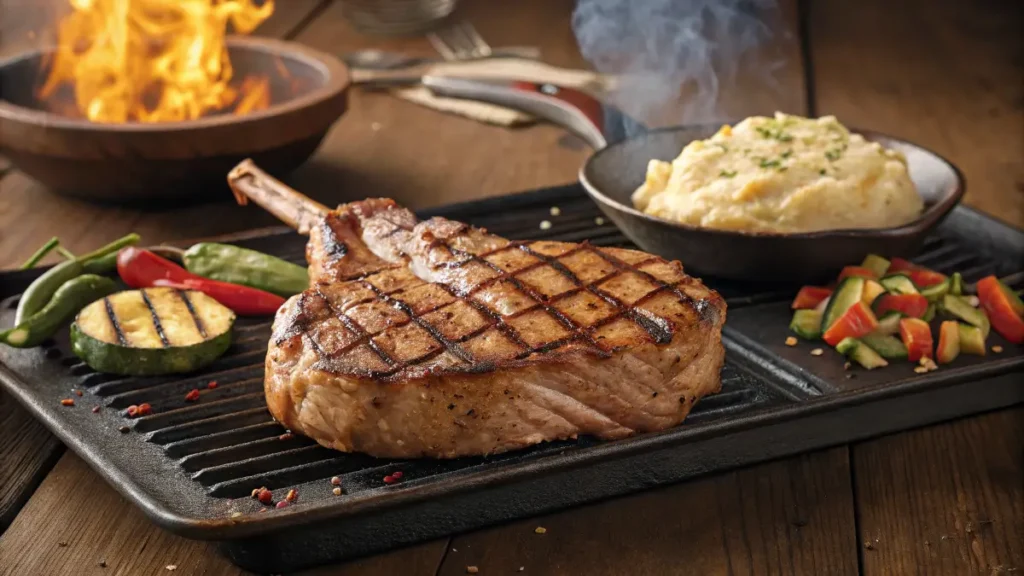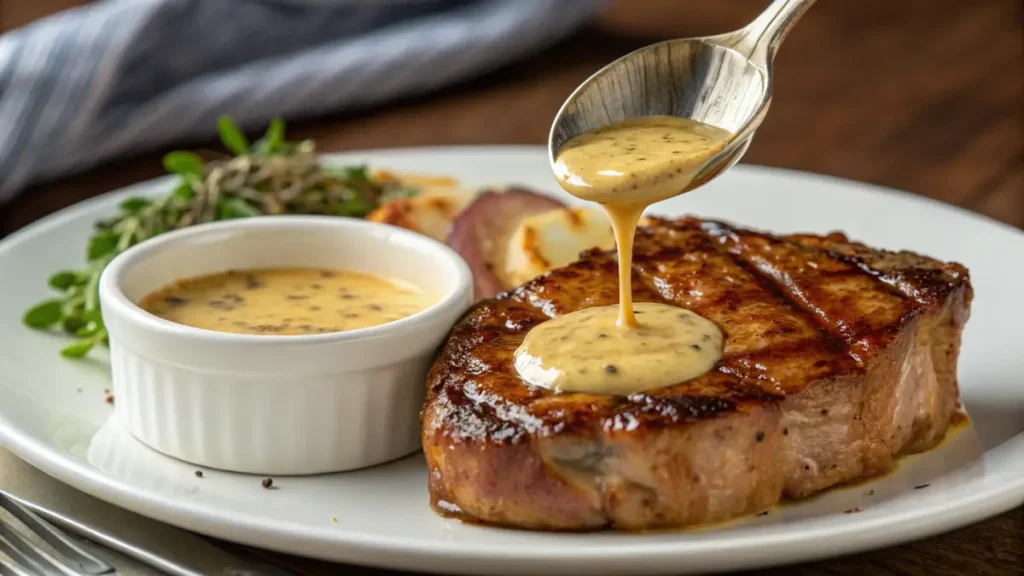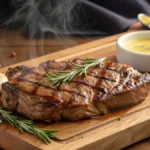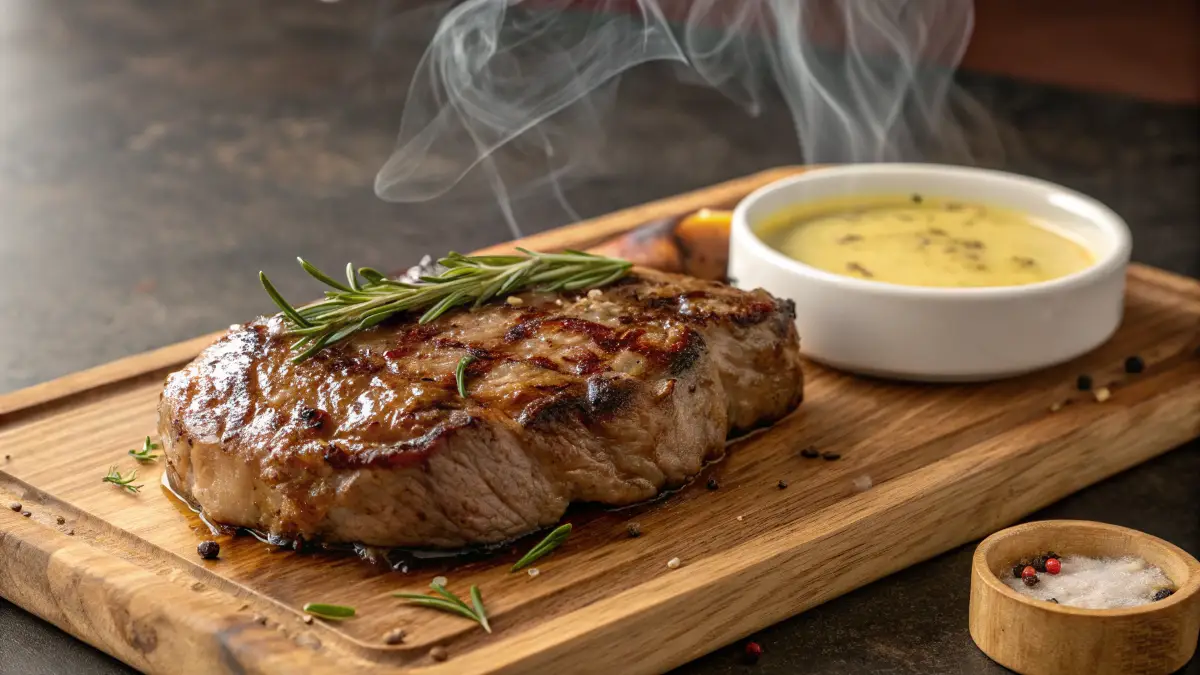Ribeye steak is one of the most loved cuts of beef, known for its rich marbling and bold flavor. But what if you’re looking for a pork alternative? Many people wonder what is the pork version of a ribeye steak, especially when they want a similar balance of tenderness and juiciness in pork.
The closest match? The pork ribeye chop. This cut, taken from the loin, has the same marbling and tenderness that make beef ribeye so delicious. But how does it compare to other pork cuts? And what’s the best way to cook it?
In this article, we’ll break it all down where pork ribeye comes from, how it differs from other pork cuts, and the best ways to cook it for maximum flavor. Whether you’re a pork lover or just looking for a great alternative to beef, you’ll find everything you need right here.
Understanding the Pork Equivalent of a Ribeye
What Makes a Ribeye Special?
The ribeye steak is prized for its high marbling, which gives it an unmatched tenderness and deep, beefy flavor. This cut comes from the rib section of a cow, specifically from between the sixth and twelfth ribs.
What makes it so good?
- Marbling – The fine white flecks of fat throughout the meat melt when cooked, making the steak juicy and flavorful.
- Tender Texture – Because it comes from an area with less muscle movement, ribeye stays tender even after cooking.
- Rich Flavor – The combination of fat and muscle structure gives ribeye a deep, savory taste that stands out from other beef cuts.
The Pork Cut That Matches a Ribeye
So, what is the pork version of a ribeye steak? The answer: the pork ribeye chop.
This cut comes from the loin, right near the shoulder, and has a similar fat-to-meat ratio as beef ribeye. Unlike leaner pork loin chops, pork ribeye chops contain more intramuscular fat, giving them a juicier, more tender texture.
Here’s what makes pork ribeye comparable to beef ribeye:
- Marbling – It has more natural fat than other pork chops, leading to better moisture and flavor.
- Tenderness – It’s softer than traditional pork loin cuts, making it great for quick, high-heat cooking methods.
- Flavor – The balance of fat and meat results in a richer, more savory bite compared to leaner pork cuts.
This makes pork ribeye chops a fantastic choice for grilling, pan-searing, or even slow cooking. But how does it compare to other pork cuts? That’s what we’ll cover next.
Pork Ribeye vs. Other Pork Cuts
When exploring what is the pork version of a ribeye steak, it’s helpful to compare pork ribeye to other popular pork cuts. Each has its unique qualities, but understanding these differences can help you choose the best cut for your meal.
Pork Ribeye vs. Pork Loin Chop
First up, let’s compare the pork ribeye chop to the pork loin chop. At a glance, these cuts may seem similar, but there are some key differences:
- Fat Content: Pork ribeye chops have more intramuscular fat than loin chops. This fat contributes to a juicier and more flavorful bite.
- Tenderness: Pork ribeye is more tender due to its higher fat content, while loin chops can be leaner and slightly tougher.
- Flavor Profile: The extra fat in pork ribeye results in a richer, more savory flavor compared to the milder pork loin chop.
When cooking, pork loin chops are often baked or grilled with marinades to keep them moist. On the other hand, pork ribeye chops can be quickly grilled or pan-seared due to their natural tenderness and flavor.
Pork Ribeye vs. Pork Shoulder Steak
Another common comparison is between pork ribeye and pork shoulder steak. While they may look similar, they come from different parts of the pig:
- Cut Location: Pork ribeye is cut from the loin, while shoulder steak comes from the shoulder area.
- Texture and Tenderness: Pork shoulder steak is tougher and benefits from slow cooking, while pork ribeye is tender enough for quick cooking methods.
- Flavor: Shoulder steak has a deeper, porkier flavor but requires longer cooking times to become tender. Pork ribeye, however, offers a balance of tenderness and flavor that’s ready in minutes.
By comparing these cuts, it’s clear that pork ribeye stands out for its balance of flavor and ease of cooking. If you’re wondering what is the pork version of a ribeye steak, the pork ribeye chop remains the top contender for its unique qualities.
Best Ways to Cook Pork Ribeye
Now that we know what is the pork version of a ribeye steak, let’s talk about cooking it to perfection. Pork ribeye chops are versatile and delicious, whether you’re firing up the grill or slow-cooking in the oven.

Grilling and Searing for Maximum Flavor
Grilling is one of the best ways to enjoy pork ribeye. The high heat creates a crispy, caramelized crust while keeping the inside juicy.
- Preheat the Grill: Ensure your grill is hot before placing the meat on it.
- Season Simply: A sprinkle of salt, pepper, and garlic powder goes a long way.
- Grill Time: Cook for 4-5 minutes per side until the internal temperature reaches 145°F (63°C).
- Rest Before Serving: Let the meat rest for a few minutes after grilling to allow the juices to redistribute.
If you prefer cooking indoors, a cast-iron skillet can mimic that grilled flavor. Just heat the skillet over medium-high heat and sear each side for about 3-4 minutes.
Slow Cooking and Roasting Options
For those who love a hands-off approach, slow cooking or roasting pork ribeye is a fantastic option.
- Slow Cooking: Place the pork ribeye in a slow cooker with onions, garlic, and your favorite sauce. Cook on low for 6-8 hours for a melt-in-your-mouth result.
- Oven Roasting: Preheat your oven to 350°F (175°C). Season the pork ribeye, then roast for 25-30 minutes until the internal temperature hits 145°F.
- Flavor Boosters: Use marinades or spice rubs to enhance the natural taste. A mix of paprika, cumin, and brown sugar makes a great rub.
Whether grilling, searing, or roasting, the pork ribeye chop is versatile and easy to cook. Knowing what is the pork version of a ribeye steak opens up a world of delicious possibilities in the kitchen.
if you’re interested in more pork-based recipes, you might enjoy checking out their Creative Leftover Pork Roast Ideas for inspiration in everytastes
Nutritional Differences Between Pork Ribeye and Beef Ribeye
If you’re wondering what is the pork version of a ribeye steak, you may also want to know how it compares nutritionally to beef ribeye. While both cuts offer protein and flavor, their fat content and calorie count can differ.
Fat Content and Protein Comparison
Pork ribeye and beef ribeye are both excellent protein sources, but their fat composition varies.
- Pork ribeye has slightly less saturated fat than beef ribeye, making it a slightly leaner option.
- Beef ribeye contains more monounsaturated fats, which contribute to its rich, buttery texture.
- Both cuts provide high-quality protein, essential for muscle growth and overall health.
Calories and Nutritional Value Table
Here’s a quick look at how pork ribeye stacks up against beef ribeye per 100g serving:
| Nutrient | Pork Ribeye | Beef Ribeye |
|---|---|---|
| Calories | 250 kcal | 290 kcal |
| Protein | 25g | 27g |
| Fat | 18g | 23g |
Pork ribeye is slightly lower in calories and fat while still providing a satisfying, juicy bite. If you’re looking for a balance of flavor, tenderness, and nutrition, pork ribeye is a great alternative to beef.
Where to Buy and How to Choose Pork Ribeye
Now that you know what is the pork version of a ribeye steak and how it compares to other cuts, let’s talk about where to buy it and how to pick the best one.
Finding Pork Ribeye at the Butcher or Store
Not all grocery stores carry pork ribeye chops, so you may need to ask your butcher. When shopping:
- Look for “pork ribeye chop” on the label. If it’s not labeled, ask the butcher for a well-marbled cut from the pork loin.
- Check for marbling white streaks of fat throughout the meat ensure better flavor and juiciness.
- Buy from local farms or specialty stores for higher-quality pork with better marbling.
Choosing the Best Pork for Flavor and Tenderness
Selecting the right pork ribeye is key to getting the best taste and texture. Here’s what to look for:
- Color: Choose cuts with a rich pink hue rather than pale or grayish meat.
- Thickness: Opt for chops that are at least 1-inch thick to prevent them from drying out during cooking.
- Pasture-Raised Pork: If available, pasture-raised pork often has better marbling and flavor.
Knowing how to pick the right cut ensures you’ll get the most out of your cooking. Whether you’re grilling, roasting, or pan-searing, the pork ribeye chop is a fantastic choice for a flavorful meal.
FAQs: Common Questions About Pork Ribeye
To wrap up our guide on what is the pork version of a ribeye steak, here are answers to some frequently asked questions.
The pork ribeye chop is the closest match to a beef ribeye steak. It comes from the pork loin and has a good balance of marbling and tenderness, making it flavorful and juicy when cooked properly.
Yes! Pork ribeye is tender, juicy, and rich in flavor, thanks to its marbling. It’s a great option for grilling, pan-searing, or slow cooking.
Pork ribeye chops are best when grilled, pan-seared, or roasted. Cook them over medium-high heat until they reach an internal temperature of 145°F (63°C), then let them rest for a few minutes before serving.
Pork ribeye is slightly lower in calories and fat than beef ribeye while still providing a high amount of protein. If you want a flavorful but slightly leaner option, pork ribeye is a great choice.
Look for pork ribeye chops at your local butcher shop or specialty grocery stores. If it’s not labeled as “pork ribeye chop,” ask the butcher for a well-marbled cut from the pork loin.
Best Side Dishes to Serve with Pork Ribeye
Once you’ve mastered cooking pork ribeye, the next step is choosing the perfect sides to complement its rich flavor. Whether you prefer classic pairings or something more creative, these options will enhance your meal.
Classic Side Dishes for Pork Ribeye
Some traditional sides bring out the best in pork ribeye without overpowering its natural taste.
- Garlic Mashed Potatoes – Creamy, buttery mashed potatoes balance the savory, juicy pork ribeye.
- Roasted Vegetables – A mix of carrots, zucchini, and bell peppers adds color and nutrition.
- Steamed Asparagus – Lightly seasoned asparagus provides a fresh contrast to the richness of the pork.
- Corn on the Cob – Grilled or boiled, corn pairs beautifully with pork ribeye’s smoky flavor.
Creative and Flavorful Sides to Try
If you want to mix things up, try these exciting side dishes that elevate your pork ribeye meal.
- Apple and Cabbage Slaw – The crisp, sweet-tart combination of apples and cabbage adds a refreshing crunch.
- Cheesy Grits – A Southern favorite, creamy grits with cheese create a rich and satisfying pairing.
- Garlic Butter Mushrooms – Sautéed mushrooms in garlic butter add depth to every bite.
- Sweet Potato Fries – A slightly sweet, crispy side that pairs well with the salty, seared pork ribeye.
Choosing the right side dish can take your pork ribeye dinner to the next level, making it a well-rounded and memorable meal.
Tips for Storing and Reheating Pork Ribeye
Cooking pork ribeye in large batches? Or maybe you have leftovers? Here’s how to store and reheat it while keeping its flavor and texture intact.
How to Store Leftover Pork Ribeye
If you have extra pork ribeye, storing it correctly helps maintain its freshness.
- Refrigeration: Place cooked pork ribeye in an airtight container and refrigerate for up to 3-4 days.
- Freezing: Wrap it tightly in plastic wrap and store in a freezer bag for up to 3 months.
- Vacuum Sealing: For even better preservation, vacuum-sealing prevents freezer burn.
How to Reheat Pork Ribeye Without Drying It Out
To keep your pork ribeye juicy and flavorful when reheating, follow these methods:
- Oven Method: Preheat your oven to 275°F (135°C), wrap the pork ribeye in foil with a little broth or water, and heat for 10-15 minutes.
- Skillet Method: Heat a pan over medium heat, add a little butter or oil, and warm the pork ribeye for 2-3 minutes per side.
- Microwave Method (Last Resort): If using a microwave, cover the pork with a damp paper towel and heat in 30-second intervals to avoid drying it out.
Proper storage and reheating keep pork ribeye just as delicious as when it was first cooked, ensuring that every bite remains tender and full of flavor.
Pairing Pork Ribeye with the Perfect Sauces

A great sauce can take pork ribeye to the next level. Whether you like something rich, tangy, or slightly sweet, there’s a perfect match for every preference.
Classic Sauces for Pork Ribeye
- Garlic Butter Sauce – A simple mix of melted butter, garlic, and fresh herbs enhances the natural flavor of pork ribeye.
- Creamy Mustard Sauce – A blend of Dijon mustard, heavy cream, and black pepper creates a tangy, rich topping.
- Homemade Barbecue Sauce – A smoky, slightly sweet sauce made with tomato paste, honey, and apple cider vinegar pairs beautifully with grilled pork ribeye.
Unique and Flavorful Sauce Pairings
- Apple Cider Glaze – A sweet-savory reduction of apple cider, brown sugar, and a splash of balsamic vinegar adds depth to every bite.
- Honey Garlic Sauce – A mix of honey, soy sauce, and garlic delivers a sticky, caramelized coating.
- Chimichurri Sauce – This Argentinian sauce, made from parsley, garlic, vinegar, and olive oil, adds a fresh, herbaceous kick.
Wine and Beverage Pairings for Pork Ribeye
The right drink enhances the flavors of pork ribeye, whether you’re serving it grilled, roasted, or pan-seared.
Best Wines for Pork Ribeye
- Pinot Noir – A light red wine with bright acidity that balances the richness of pork ribeye.
- Zinfandel – This fruity, bold wine pairs well with smoky, grilled pork ribeye.
- Chardonnay – A buttery, oaked Chardonnay complements the tender texture of pork ribeye.
Non-Alcoholic Pairings
- Apple Cider – A naturally sweet and tangy drink that highlights pork’s juicy flavors.
- Herbal Iced Tea – A chilled chamomile or mint tea provides a refreshing contrast.
- Sparkling Water with Citrus – Lemon or lime-infused sparkling water keeps the palate refreshed.
Conclusion
Now that we’ve explored what is the pork version of a ribeye steak, it’s clear that the pork ribeye chop is the best match. With its rich marbling, tender texture, and bold flavor, it’s a fantastic alternative to beef ribeye. Whether you’re grilling, pan-searing, or slow-cooking, this cut delivers a satisfying and juicy bite every time.
We also covered how pork ribeye compares to other pork cuts, the best cooking methods, its nutritional differences from beef ribeye, and even side dishes to complete your meal. Plus, with proper storage and reheating techniques, you can enjoy pork ribeye leftovers without losing flavor or texture.
If you’re looking for a delicious, versatile, and easy-to-cook pork cut, pork ribeye is the answer. The next time you’re at the butcher or grocery store, don’t hesitate to try it you might just find your new favorite cut of meat!
Print
What is the Pork Version of a Ribeye Steak?
- Total Time: 20 minutes
- Yield: 2 servings 1x
- Diet: Low Calorie
Description
This juicy pork ribeye steak is pan-seared to perfection with a garlic butter glaze, giving you a delicious, restaurant-quality meal at home.
Ingredients
- 2 pork ribeye chops
- 2 tbsp olive oil
- 2 tbsp butter
- 3 cloves garlic (minced)
- 1 tsp salt
- ½ tsp black pepper
- ½ tsp smoked paprika
- 1 tsp fresh rosemary (chopped)
- 1 tbsp lemon juice
Instructions
- Prepare the Pork: Pat the pork ribeye chops dry with paper towels and season with salt, pepper, and smoked paprika.
- Heat the Pan: In a skillet over medium-high heat, add olive oil and sear the pork for 4-5 minutes per side.
- Add Butter & Garlic: Lower the heat to medium, add butter, minced garlic, and rosemary. Spoon the melted butter over the pork.
- Rest & Serve: Remove from heat, drizzle with lemon juice, and let rest for 5 minutes before serving.
Notes
10
- Prep Time: 10 minutes
- Cook Time: 10 minutes
- Category: Main Course
- Method: Pan-Searing
- Cuisine: American
Nutrition
- Serving Size: 1 pork ribeye chop
- Calories: Calories: 350
- Sugar: 0g
- Sodium: Sodium: 480mg
- Fat: Fat: 22g
- Saturated Fat: Saturated Fat: 9g
- Unsaturated Fat: Unsaturated Fat: 11g
- Trans Fat: 0g
- Carbohydrates: Carbohydrates: 1g
- Fiber: Fiber: 0g
- Protein: Protein: 38g
- Cholesterol: Cholesterol: 110mg
Keywords: pork ribeye, pork steak recipe, juicy pork ribeye, best pork steak

